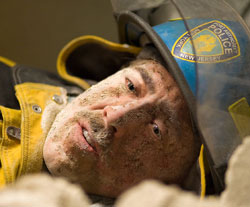Say what you will about Malibu elitists who scorn Bush, God, the heartland, and the whole project of post-9/11 American interventionism abroad. Oliver Stone has never really been in that camp. The figures at the center of his very square (and surprising to some) World Trade Center are consistent with the outer- borough, blue-collar heroes of Wall Street, the ordinary grunts of Platoon, even the NFL linemen of Any Given Sunday. A child of Manhattan privilege, a Yale dropout who went to Vietnam as an infantryman (where he was wounded and earned a Bronze Star fighting in a war he opposed), the three-time Oscar winner is a natural choice for this patriotic, sentimental footnote to the 9/11 attacks. His mandate, really, isn’t to make a thriller about the many failures of U.S. intelligence and policy that might’ve pre-empted Al Qaeda’s actions that day. (Look for more of those, based on many current books, including Against All Enemies, being directed by Crash‘s Paul Haggis.) All he’s been hired to do, really, is honor a pair of Port Authority cops who were buried during the twin towers’ collapse, then later miraculously plucked from the rubble—two of only 20 rescued alive from Ground Zero. In other words, theirs is the exceptional story, certainly true and inspirational, but small in relation to events around them. Stone does an honorable job of telling their story, even if it’s not terribly cinematic or dramatic.
With Lon-guy-land vowels and steel-brush mustache, Nicolas Cage plays the senior of two PAPD officers pinned by debris, John McLoughlin, who’s got a wife (Maria Bello) and kids out in the suburbs. Michael Peña plays the rookie, Will Jimeno, who has a pregnant wife (Maggie Gyllenhaal) over in Joisey. They are, emphatically, ordinary men, not headline grabbers. (“What good did we do?” McLoughlin later wonders, after the sky has fallen.) McLoughlin has the simple stoic courage to rally his squad that morning, rush downtown, and run into the buildings for evacuation. Then the towers crumble on top of them. Their work is over before it even begins.
So, in some sense, is the movie. Stone opens it with a loving montage of Manhattan’s quiet dawn streets. The mighty Hudson, the low Atlantic sun, the city slowly stretching its muscles for another day—even though Aaron Copland’s “Fanfare for the Common Man” isn’t playing, that’s the mood.
Trouble is glimpsed indirectly by the shadow of a jet cast against a building. The impacts aren’t shown, just repeated on TV. Only as McLoughlin and his men commandeer a bus down Seventh Avenue does Stone show us the wounded, smoldering giants. The feeling is one of controlled panic amid the rain of ash, glass, and spreadsheets; by a kind of group choreography, everyone they pass on the sidewalk performs the same incredulous craning of the neck at something seen and yet not believed.
These computer effects are fairly seamless, the city and the newsreel merged into one. Once McLoughlin is inside the World Trade Center, the CG is more speculative. Stone imagines a kind of earthquake and shock wave when the first (south) tower implodes. It’s scary, but less frightening than the anticipatory sounds McLoughlin hears above him—the unspecified “thuds” and “thunks” of what . . . debris, steel, people? He and his men are like the submarine crew waiting out the depth charges. What they imagine is terrible; what they can’t imagine is beyond that.
BEING CONFINED to an infernal tangle of concrete and steel is bad enough for our heroes, of course, but it’s worse for the filmmaker. Hewing to the facts, Stone has to position his actors so they can’t see each other, can’t appear in the same shot, can’t even move. Cage, usually the most kinetic of actors, is basically reduced to using his eyes, only he’s also coated, Kabuki-like, in ash. To get out of this suffering filmmaking pit, Stone heads out to the suburbs to suffer with the women, where every banality (“How ’bout a waffle?”) is torture to the wives waiting for their husbands. And if the two trapped men begin to hallucinate, Stone also lets us see Jesus with a water bottle or Bello nagging Cage to finish installing their kitchen cabinetry. Yet there’s no escaping the fact that his protagonists can’t escape on their own; they’re like Winnie in Beckett’s Happy Days—half buried and babbling of better things—but Stone daren’t risk darkening things further with existentialism.
Appearing a few months after the excellent and harrowing United 93, this film can’t help but draw unfavorable comparisons. There, people rushed into action aboard a flying jet, which suited Paul Greengrass’ intimate, highly mobile camera style. Which also would’ve suited Stone just fine, had he been offered the job. But, after Alexander, this is the one he got. As he told The New York Times recently of his studio employers, “This is not a political film. That’s the mantra they handed me.” And he agreed to those terms when he cashed the check.
It’s a pity that when films like Syriana and books like Against All Enemies consider how opium and oil and Islamo-terrorism have permeated our political system, the creator of JFK can’t lend his own interpretation of world events. Michael Moore had his turn in Fahrenheit 9/11. Mel Gibson may yet direct a movie about how the Jews secretly perpetrated the September attacks. But Ground Zero is not the place for dissent. And for now, neither is the multiplex.








